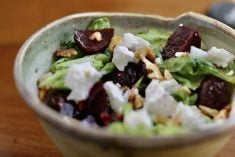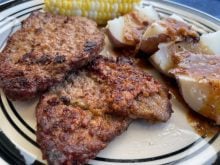Serving up amazing local beef on the grill is a great way to celebrate Canada Day.
There are two choices for the fuel for barbecue: gas or charcoal. Gas is convenient and heats up in a matter of minutes, but you can’t beat charcoal for the heat needed to get a good hard sear.
When you are ready to cook, create zones on the grill. Have one side very hot to get that good sear, a middle that is medium and a side that is entirely free of coals or flame. On a gas grill, the area with no direct heat is the rack attached to the lid. This last zone is a place to rest ingredients that might cook too fast or you just want off the flame.
Read Also

Understand limitation periods if considering civil suit
A limitation period refers to the amount of time a plaintiff has to commence a formal claim in court or lose their ability to pursue it.
Tender slow-barbecued beef ribs
Long beef ribs usually come in a set of three ribs. You can find them sold as single ribs, but the whole slab works better, otherwise the meat can dry out during cooking.
Plan on about 1 1/2 pounds (750 grams) per person.
These ribs pack a punch when it comes to flavour. There is a lot of fat and connective tissue in this meat, so when it is cooked down, you get a rich, beefy taste.
The best way to cook them is low and slow so the fat can break down while the meat stays moist.
Remove the membrane, called the silverskin, from the underside of the rack. It is tough and will not tenderize. Use the blunt tip of a table knife to slip under the silverskin over the bone and then carefully pull it off in one piece.
Season the meat with a simple rub using equal parts pepper and kosher salt. Add garlic powder, onion powder and truffle powder, to taste. Large ground salt and pepper flakes give a seasoned texture, while subtle garlic, onion and truffle enhance classic beef flavours. Apply to all sides of the ribs.
Prepare a gas or charcoal grill for indirect heat. Adjust the heat on the active burner to maintain 250 F (120 C). When the grill is up to temperature, place ribs on the cool side of the grill to cook indirectly. Close the lid and cook until the ribs are tender, turning every 15 minutes, about three hours depending on meatiness of the ribs.
When the meat reaches an internal temperature of 165 F (74 C), it is ready to serve. Check in several spots and try not to touch the bone with the tip of the thermometer.
You can apply barbecue sauce during the last 15 minutes of cook time and cook over direct heat, if you like. Keep a close eye on the ribs so they don’t burn.
Leftovers will keep well in the fridge, wrapped in foil, for up to four days.
Smash burgers
Smashing down on the burger balls within the first 30 seconds of hitting a hot grill ensures maximum juiciness and a flavourful, well-browned crust. When you smash the burger down, you are creating more surface area for browning. Be careful because the high fat content in this ground beef will cause flare-ups. Have a water spray bottle handy to put out flames.
You will want to start with the beef very cold. If the beef warms up while you are making the burgers, the fat can separate from the meat, making the burgers sticky while forming balls and tough when cooked.
Burger sauce
- 1/4 c. mayonnaise 60 mL
- 1/4 c. ketchup 60 mL
- 1/4 c. spicy brown
- mustard 60 mL
- 2 garlic cloves, minced
- 1 tbsp. white vinegar 15 mL
- 1/8 tsp. cayenne pepper .5 mL
- 1/8 tsp. smoked paprika .5 mL
- salt and pepper, to taste
- pinch of sugar, to taste
Burgers
- 1/4 c. butter, melted 60 mL
- 1 tbsp. Worcestershire
- sauce 15 mL
- 1/2 tbsp. fish sauce 7 mL
- 1 lb. ground chuck 500 g
- kosher salt and black
- pepper, to taste
- cheese, any kind you choose
- brioche buns, buttered and toasted
- toppings of choice but try to keep it simple
Mix all ingredients for the burger sauce, and set aside in the fridge.
Mix the melted butter, Worcestershire sauce and fish sauce together in a small bowl. Add the beef. Gently break up the beef with a wooden spoon or your hands and gently mix thoroughly. Do not over-work your meat; be very gentle with it.
When thoroughly mixed, scoop into three or four ounce (85 – 115 g) sized balls. Be sure to make balls and not patties. Cover the burger balls with plastic wrap and refrigerate for a minimum of a half hour. You want the meat to be very cold. You could also pop into the freezer for 15 minutes.
When ready to cook, heat your grill until super hot. Remove burgers from the fridge and season them generously with kosher salt and pepper. Place balls on the grill, leaving room for them to be smashed down. After 30 seconds of searing, smash them all the way down until they cannot be smashed anymore, with a large heavy skillet. Leave them alone and let them cook for about three to four minutes, or when the edges turn brown. Flip them over and immediately place a slice of cheese on top of each patty. When the cheese melts, they are ready, about one to two minutes longer.
Build your burger with the toppings of your choice.
Lemongrass beef skewer wraps
It is easier to slice the beef thinly if it is partially frozen first.
Seasoned cucumbers
- 1/2 English cucumber,
- thinly sliced
- 2 tbsp. rice vinegar 30 mL
- juice of 1 lime
- 1 tbsp. vegetable oil 15 mL
- 1 tbsp. fresh basil, in a
- chiffonade 15 mL
- 1 tbsp. fresh mint, in a
- chiffonade 15 mL
- 2 tsp. fish sauce 10 mL
- 1 tbsp. sambal hot sauce 15 mL
Beef Skewers
- 2 lemongrass stalks,
- bottom 4 inches only,
- pounded and minced
- 1/4 c. fish sauce 60 mL
- 2 tbsp. honey 30 mL
- 1 garlic clove, minced
- 1 tbsp. vegetable oil 15 mL
- 1 lb. boneless sirloin,
- trimmed 500 g
- 1/4 c. roasted salted peanuts,
- crushed 60 mL
- bibb or leaf lettuce, for serving
Soak 16 bamboo skewers in cold water for 30 minutes.
Combine rice vinegar, lime juice, vegetable oil, fish sauce and sambal and whisk together. Stir in mint and basil. Pour over cucumber slices in a medium bowl. Toss to combine, and set aside for 15 minutes.
Meanwhile stir together minced lemongrass, fish sauce, sugar, garlic and oil. Slice beef thinly against the grain. Add to marinade and toss. Let stand at room temperature for 20 minutes.
Preheat a grill to medium-high heat. Thread beef onto skewers that have been soaked in water for 30 minutes. Grill until browned, about one minute per side. Transfer to a platter, tent with foil and let rest five minutes. Sprinkle with peanuts.
To serve, set out meat skewers, lettuce leaves and seasoned cucumber so everyone can make their own wraps.
Sarah Galvin is a home economist, teacher and avid supporter of local food producers. She has been a market vendor, grew up on a farm in southeastern Saskatchewan and is a member of TEAM Resources.


















